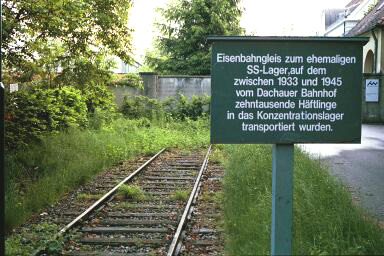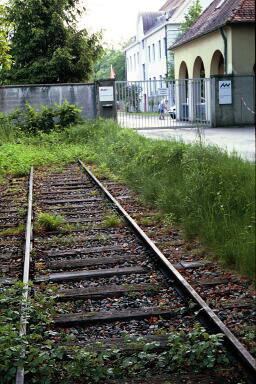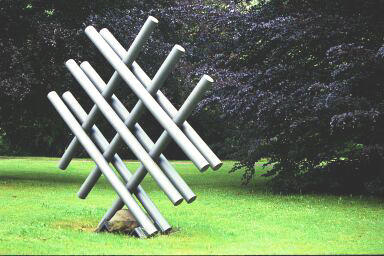Section of preserved railroad trackOne of the mass transports of prisoners which made use of the siding included 120 beggars and tramps. These people arrived at Dachau station at 4:30 p.m. on July 15, 1936. The Bavarian Secret Police informed the camp commandant, SS-Oberführer Hans Loritz, in advance that these 120 people "are to be transported directly from Dachau station in 3 rail cars via the industrial siding to Dachau concentration camp." Hans-Günter Richardi, Dachau: A Guide to its Contemporary History  A short railroad branch line, or rail siding, was built in 1915 from the train station in Dachau to the gunpowder and munitions factory. In July 1936 when the Nazis acquired all the property of the abandoned gun powder factory, construction began on an SS training camp and garrison, which was built next to the concentration camp that had opened in 1933. On September 23, 1936 the industrial railroad branch line, that had formerly served the munitions factory, became the property of the Nazis. It was used primarily to bring supplies into the SS camp, but a few transport trains carrying prisoners also arrived on this railroad line, which went a short distance inside the SS camp through a railroad gate on the southwest side of the complex. The railroad tracks did not extend into the concentration camp.  A short piece of the track on this branch line has been preserved as a memorial to the prisoners who entered the Dachau complex by train. The rest of the branch line was ripped out in 1985. The English translation of the sign reads "Railroad track to the former SS camp where between 1933 and 1945 tens of thousands of prisoners were transported into the concentration camp." To find this preserved section of the track, go to John F. Kennedy Plaza which is on the north side of Sudetenlandstrasse, near where it intersects with Friedenstrasse. A sculpture from the Dachau '95 exhibit, shown in the photograph below, marks the John F. Kennedy Plaza; the sculpture faces Sudetenlandstrasse and is directly across from a bus stop for bus #720 coming from old town Dachau. To reach this spot, I got on bus #720 in front of the Zieglerbräu Hotel on Konrad-Adenauer-Strasse, one of the main streets in old town Dachau, and got off on Sudetenlandstrasse, just past the intersection with Friedenstrasse.  As you face the sculpture shown above, keep walking straight ahead (north) through the plaza until you see a street that runs along the western fence of the former SS camp. The street goes past some nice new houses, and ends at the entrance to the Dachau Volunteer Fire Department where you will see a sign marking the preserved section of the train tracks. Surprisingly, the memorial sign does not mention the "death train" which arrived after a 220-mile trip from Buchenwald and was abandoned on these very tracks on April 27th, two days before the American Seventh Army liberated the camp. The ill-fated journey had taken three weeks because of delays caused by American bombing and many of the prisoners had been killed by American planes strafing the open cars on the train. It was the sight of the corpses on this train that enraged the American soldiers of the 45th Infantry Division to the point that they lined up Waffen-SS soldiers from the Training Camp and garrison, who had just surrendered, and mowed them down with a machine gun. The photograph below, taken in May 1945, shows a memorial to the German soldiers of World War I and in the background is the train from Buchenwald with its cargo of bodies of prisoners who died before the train arrived in Dachau. The abandoned train was 39 cars long and part of it was on the tracks near what is now John F. Kennedy Plaza.  From John F. Kennedy Plaza, take the street which curves around from the plaza to the east, and you will be on the street formerly called the Avenue of the SS. The name of the street is now Strasse der KZ-Opfer. Avenue of the SSGates into Dachau complexHistory of the SSBack to SS CampBack to Table of ContentsHome |